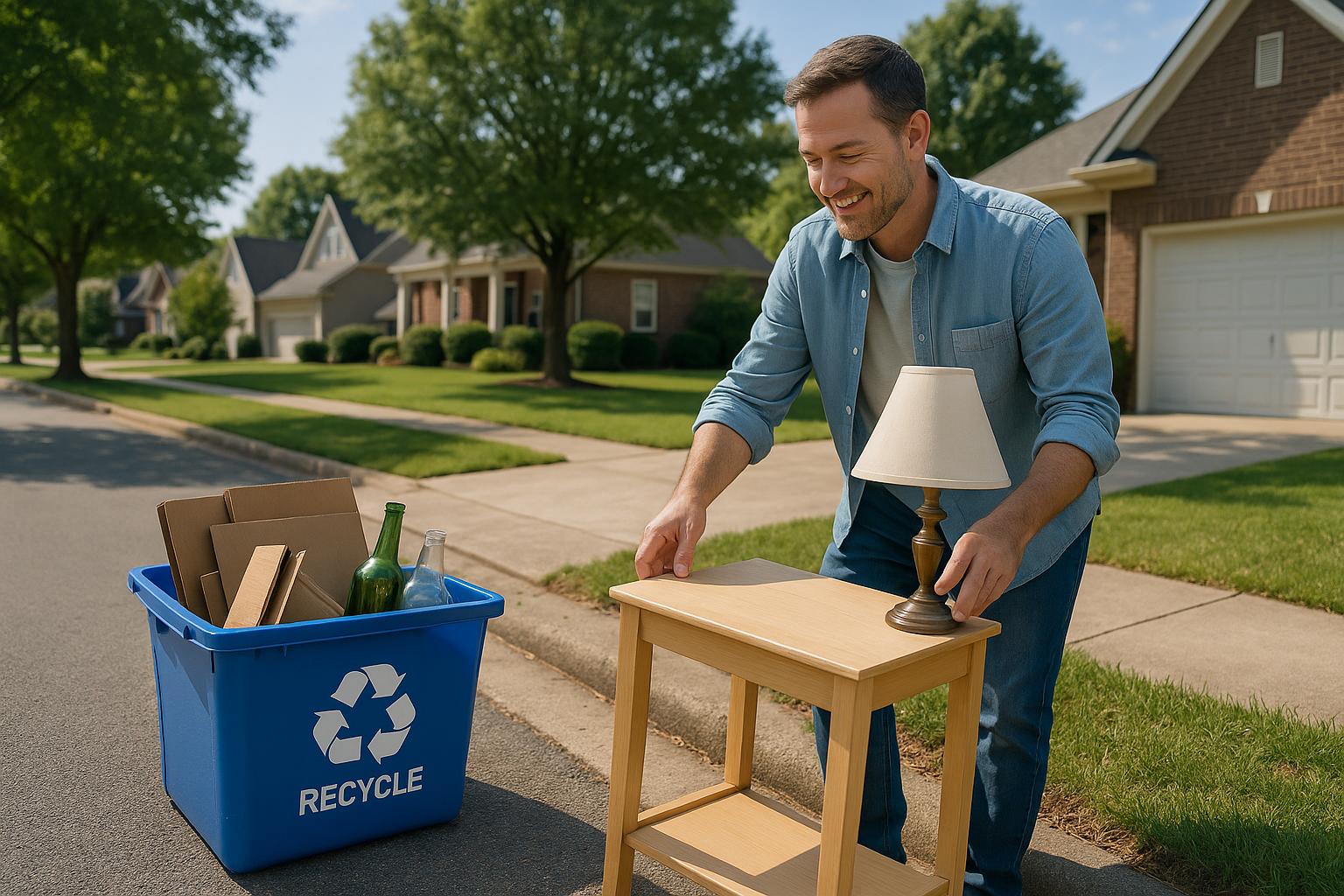In junk removal, tracking customer satisfaction is key to success. Here are 7 essential metrics every business should measure:
- CSAT (Customer Satisfaction Score): Measures how happy customers are with your service. Aim for 75-90%.
- NPS (Net Promoter Score): Tracks customer loyalty and likelihood to recommend your service. Scores above 30 are great.
- Response Time: How quickly you respond to inquiries. Fast responses (e.g., under 10 minutes for calls) improve satisfaction.
- Service Completion Rate: Percentage of jobs finished on schedule. Top companies hit 95%+.
- Repeat Customer Rate: Tracks customer loyalty. Rates above 40% indicate strong retention.
- Service Quality Ratings: Evaluates professionalism and job execution. Aim for 80%+ satisfaction.
- CES (Customer Effort Score): Measures how easy it is for customers to interact with your business. Low effort = higher loyalty.
These metrics help businesses improve operations, retain customers, and grow. Tools like WasteMatch can simplify tracking and boost performance.
How to Measure Customer Satisfaction: 6 Key Metrics Unlocked
1. Customer Satisfaction Score (CSAT)
CSAT is a key way to measure how happy customers are with your junk removal service. It provides direct feedback, helping businesses see how well they're meeting customer expectations right after completing a job.
To measure CSAT, you ask customers a simple question: "How satisfied are you with our service?" Responses are usually on a scale of 1-10. The score is then calculated as the percentage of customers who report being satisfied.
Monitoring CSAT can highlight areas like service quality, staff behavior, and overall customer experience. Generally, a score above 90% is considered outstanding, 75-85% is solid, and anything under 75% indicates room for improvement.
For best results, gather feedback immediately after finishing a job. Look for patterns in the responses to pinpoint areas that need attention, and compare your scores to the industry benchmark of 75-85%.
Research shows that 78% of U.S. consumers stopped doing business with a company in the past year due to bad customer service. Regularly tracking and acting on CSAT feedback can help junk removal companies build trust and ensure long-term growth.
While CSAT captures short-term satisfaction, the Net Promoter Score (NPS) is a better tool for understanding long-term customer loyalty.
2. Net Promoter Score (NPS)
NPS evaluates customer loyalty by asking a simple question: "On a scale of 0-10, how likely are you to recommend our junk removal service to a friend or colleague?"
Here's how responses are categorized:
| Category | Score Range | Description |
|---|---|---|
| Promoters | 9-10 | Loyal customers who are likely to recommend you |
| Passives | 7-8 | Satisfied but not overly enthusiastic customers |
| Detractors | 0-6 | Unhappy customers who might discourage others |
For example, if 60% of respondents are promoters and 20% are detractors, your NPS is 40. This score is well above the industry average of 30 and provides a clear benchmark for assessing your performance against competitors while setting realistic goals for improvement.
Tips for using NPS effectively:
- Send digital surveys right after the service to gather fresh feedback quickly.
- Address issues raised by detractors promptly to prevent negative reviews or word-of-mouth.
- Monitor your score over time to identify trends or recurring challenges.
NPS isn't just a number - it's a tool for action. Many junk removal companies use NPS feedback to improve in key areas like service timing, pricing clarity, and crew training.
When combined with CSAT, NPS offers a more complete view of customer satisfaction. While NPS highlights loyalty and referral potential, elements like Response Time reveal how effectively you're meeting customer needs - a critical part of the satisfaction equation.
3. Response Time
Studies reveal that 89% of customers value fast support, making response time a major factor in customer satisfaction. For junk removal businesses, this metric tracks how quickly you respond to inquiries and service requests.
Here’s what customers typically expect based on the communication channel:
| Communication Channel | Expected Response Time |
|---|---|
| Phone Calls | Under 10 minutes |
| Live Chat | Under 5 minutes |
| Email Inquiries | Within 12-24 hours |
| Social Media | Within 4 hours |
Interestingly, 67% of customers expect a response within 10 minutes for service-related inquiries. Meeting these expectations is especially important in a time-sensitive field like junk removal.
What Affects Response Time?
Several factors influence how quickly you can respond:
- Staffing levels, training, and coverage hours
- Efficient management of communication channels
- Systems for prioritizing inquiries
- Use of automation for initial responses
Tools like WasteMatch can help streamline communication and speed up responses by automating parts of the process.
"Fast response times are a proven strategy for building customer loyalty."
To stay ahead, aim for consistent response times across all platforms. Automated replies can acknowledge inquiries quickly, but ensure a meaningful follow-up happens within the expected timeframe. Responding promptly can increase booking rates by up to 50%.
In the junk removal industry, quick responses build trust and improve customer satisfaction. While response time is the first step, timely job completion is just as critical for a great customer experience.
4. Service Completion Rate
Service Completion Rate (SCR) shows the percentage of jobs finished as planned. It’s a key factor in earning customer trust and keeping them satisfied. A high SCR signals reliability and tells customers their time and needs matter.
Top junk removal companies usually have completion rates above 95%, showing strong service performance. Dropping below 90% can lead to unhappy customers and problems with retention.
Here’s how completion rates align with customer satisfaction:
| Completion Rate | Impact on Customer Satisfaction | Business Outcome |
|---|---|---|
| 95%+ | High satisfaction | Strong retention & referrals |
| 90-94% | Moderate satisfaction | Average retention |
| Below 90% | Low satisfaction | High customer churn |
An industry study found that 90% of customers who received timely and reliable service reported being highly satisfied, compared to only 50% of those who experienced delays. This underscores how crucial it is to meet scheduling commitments.
To keep SCR high, focus on these areas:
- Use efficient scheduling tools.
- Train employees to handle jobs effectively.
- Maintain clear, real-time communication.
- Implement strong quality control processes.
Tools like WasteMatch can simplify scheduling and resource management, helping companies stay on track with their commitments.
"A high Service Completion Rate is critical for building customer trust and loyalty. Companies that consistently complete jobs as scheduled see significantly higher customer retention rates and positive referrals."
Completing jobs on time not only builds trust but also drives repeat business and word-of-mouth referrals. Companies with SCR above 95% often see better customer loyalty and steady growth.
However, delivering on time isn’t enough. Retaining customers also depends on maintaining excellent service quality, which ties directly to Service Quality Ratings.
sbb-itb-c7714ed
5. Repeat Customer Rate
Repeat Customer Rate (RCR) tracks how many customers return for additional junk removal services. Industry benchmarks suggest successful companies usually have RCRs between 20-40%, with rates above 50% showing outstanding customer loyalty and service.
Here’s how RCR ties into business performance:
| Repeat Customer Rate | Business Performance Level | Impact on Revenue |
|---|---|---|
| Above 50% | Outstanding | Strong growth, lower customer acquisition costs |
| 30-50% | Solid | Consistent growth, steady revenue |
| 20-30% | Average | Moderate growth, higher focus on acquiring new customers |
| Below 20% | Needs Work | Limited growth, increased marketing expenses |
RCR can help uncover customer behavior patterns. For example, analyzing when customers return could reveal seasonal trends or highlight which services - like estate cleanouts or bulk item pickups - encourage repeat business.
To improve repeat rates, prioritize consistent service quality, fair pricing, and clear communication. Companies like WasteMatch excel in this area by simplifying scheduling, maintaining transparent pricing, and staying proactive in customer communication.
"Customer retention is significantly more cost-effective than new customer acquisition, making a strong repeat customer rate essential for sustainable growth in the junk removal industry".
Tracking RCR alongside satisfaction metrics offers a more complete picture of business health. Paired with customer feedback, it pinpoints areas for improvement that can strengthen loyalty.
High RCR reduces the need for expensive customer acquisition efforts and signals customer satisfaction. However, keeping service quality high is the foundation for earning and keeping that loyalty.
6. Service Quality Ratings
Service quality plays a key role in keeping customers happy, which directly impacts loyalty and referrals. This metric breaks down specific aspects of junk removal services, such as how clean the job site is left and how professional the staff is.
Industry data shows that junk removal companies should aim for a service quality rating of at least 80%. Hitting this mark often leads to stronger customer loyalty and more referrals. On the other hand, companies with ratings below 75% tend to see more customer complaints and a higher churn rate.
Here’s how top-performing companies track service quality:
| Quality Component | Target Benchmark |
|---|---|
| Service Execution | 90% or higher |
| Staff Professionalism | 85% satisfaction |
Tools like WasteMatch simplify the process by automating feedback collection. These tools allow businesses to monitor service quality in real time and quickly address any issues, keeping standards consistent and identifying areas to improve.
To boost service quality ratings, businesses can focus on:
- Ongoing staff training
- Regular quality control checks
- Ensuring job sites are clean after service
- Monitoring job timing for efficiency
The connection between service quality and business success is clear:
| Rating Level | Business Impact |
|---|---|
| Above 85% | Increased loyalty and more referrals |
| 75-85% | Stable customer base with moderate growth |
| Below 75% | Higher churn rates and more complaints |
"Evaluating customer satisfaction and retention is essential for any junk removal company, as it directly impacts the business's success and growth." - Lightning Haul Blog
Consistent quality checks after each job help maintain high customer satisfaction. CRM systems and other specialized tools make it easier to track performance metrics and address potential issues before they escalate.
While service quality ratings measure how well your operations perform, understanding how easy it is for customers to do business with you is just as important. That’s where the Customer Effort Score comes into play.
7. Customer Effort Score (CES)
While service quality focuses on how well tasks are completed, CES zeroes in on how easy it is for customers to interact with your business. According to Gartner, 96% of customers who face high-effort interactions become disloyal, compared to just 9% who experience low-effort interactions.
CES is typically measured through post-service surveys, where customers rate how simple the service was to use. High scores (6-7) indicate strong loyalty and cost savings, while low scores (1-3) often signal churn and dissatisfaction.
Junk removal companies aiming to boost CES often focus on reducing friction in key areas, such as:
- Simplifying booking with online scheduling tools
- Providing real-time updates to keep customers informed
- Offering multiple payment options for convenience
- Resolving issues in a single interaction
Platforms like WasteMatch help streamline these processes, making operations smoother. Research shows that reducing customer effort builds loyalty more effectively than trying to exceed expectations. For junk removal businesses, this means prioritizing:
- Transparent, upfront pricing
- Flexible scheduling to meet customer needs
- Clear and consistent communication
- Quick resolution of any problems
The impact is clear: 94% of customers who report low-effort experiences say they would repurchase, and 88% are willing to spend more. This makes CES more than just a satisfaction metric - it's a strong indicator of future business growth.
Measuring CES right after key moments, like service completion, ensures accurate feedback. This allows businesses to address issues promptly, boosting loyalty and cutting down churn.
Conclusion
Tracking and improving customer satisfaction in the junk removal industry requires focusing on seven key metrics: CSAT, NPS, Response Time, Service Completion Rate, Repeat Customer Rate, Service Quality Ratings, and CES. Together, these metrics give a clear picture of how customers perceive your service and how well your business is performing.
Data shows that junk removal companies with CSAT scores over 80% and response times under 30 minutes consistently outperform competitors. High service completion rates - above 90% for top performers - also play a major role in keeping customers happy and driving business growth.
Tools like WasteMatch make it easier to manage these metrics by offering real-time response tracking, automated feedback collection, and streamlined communication systems. Using such platforms can help businesses improve retention and generate more referrals.
For companies aiming to improve these metrics, the focus should be on creating a structured measurement system while ensuring operational efficiency. Balancing excellent service with cost management becomes much more achievable with the right tools in place.
As the industry moves toward real-time customer satisfaction tools, businesses that embrace these advancements while keeping these core metrics in check will be better equipped to grow in an increasingly competitive market.
These metrics are not just numbers - they represent customer experiences and overall business health. By consistently working to improve in these areas, junk removal businesses can build stronger customer relationships and achieve greater operational success.
FAQs
Here are answers to common questions about measuring customer satisfaction in junk removal services.
What are the best metrics for customer satisfaction?
Measuring customer satisfaction effectively requires a mix of numbers and customer feedback. Many leading junk removal companies track these seven key metrics:
| Metric | Description |
|---|---|
| CSAT (Customer Satisfaction Score) | Gauges overall satisfaction with the service |
| NPS (Net Promoter Score) | Measures how likely customers are to recommend your service, grouping them by loyalty |
| Response Time | Tracks how quickly you respond to inquiries - aim for under 30 minutes |
| Service Completion Rate | Measures the percentage of jobs completed on schedule |
| Repeat Customer Rate | Tracks how many customers come back for additional services |
| Service Quality Ratings | Evaluates professionalism and thoroughness of the service |
| CES (Customer Effort Score) | Assesses how easy it was for customers to complete their service request |
When monitored consistently, these metrics help create a clear picture of customer satisfaction. Companies that respond quickly and stick to schedules often see higher retention rates.
"Evaluating customer satisfaction and retention is essential for junk removal companies as it directly impacts business success and growth. Customer satisfaction leads to repeat business and referrals, which can enhance profit margins and drive new client acquisition."
Using modern tools, businesses can track these metrics in real time, making it easier to gather feedback and make improvements. By prioritizing these areas, junk removal companies can deliver better service, build customer loyalty, and stay ahead of the competition.


